Damn, that tram is crammed!
It seems like a great idea but the Tram 28’s popularity has also ruined it for everyone. Luckily, I’ve got a solution!
Written by Michael Turtle
Michael Turtle is the founder of Time Travel Turtle. A journalist for more than 20 years, he's been travelling the world since 2011.
Michael Turtle is the founder of Time Travel Turtle and has been travelling full time for a decade.
Updated: February 28, 2024

How to beat the queues for the Tram 28 in Lisbon
I've put together a suggestion for how to avoid the wait for the Tram 28 in Lisbon: Walk the route!
Not only will you see all the same sights, but you'll actually be able to pop in and visit them. Then you can catch the tram back to the start (which is much less crowded).
- How to plan your walk along the Tram 28 route
- A map of Lisbon's Tram 28 route
Things to see on the Tram 28 in Lisbon
- Some practical tips for riding the Tram 28 in Lisbon
Often when we arrive in a city, we take some time to plan what we want to see and how to get between those sights. Or maybe, not knowing what the best itinerary would be, we join a guided tour that can lead us around the highlights.
But what if a city had already created the perfect sightseeing path. Not for tourists, though. Just by accident.
Well, that’s what happened in Lisbon, with one of the city’s public transportation routes – the Tram 28. It was designed to be convenient for the residents, but it ended up going past many of Lisbon’s most important landmarks.
The problem, though, is that the route of Lisbon’s Tram 28 is a little too perfect!
Lisbon used to be full of tram lines but they’ve slowly disappeared over the years as the city’s underground metro system was built and expanded. Trams have mainly been kept in areas where the metro can’t be built – up hills, for example. So there are only five lines left across the city.
One of these, the tram 28 Lisbon line, was developed in 1914 and was designed to take residents from the central Baixa district to neighbourhoods like Graca and Estrela. Unfortunately, these trams have become effectively useless for locals in the past few years for one simple reason – tourists!
Because the tram goes past so many sights and charming neighbourhoods, it’s now used by international visitors as a way to see the city.
Why is the Tram 28 in Lisbon famous?
Although the Tram 28 is just a normal line of public transportation in Lisbon, it happens to go past many of the city’s most significant landmarks in districts like Alfama, Baixa, and Estrela. Because the route also uses some heritage-style tram carriages, it’s become a popular tourist attraction in the city.
How long is the wait for the Tram 28 in Lisbon?
Because the Tram 28 offers a very good value city tour, with a little slice of heritage, there are usually long lines to get on. It’s not uncommon for people to wait more than an hour to get on the Tram 28, and in the busy tourist seasons the queue could take more than two hours!
Does the Lisboa Card include the Tram 28?
Yes, because the Lisboa Card includes public transportation in Lisbon, it also includes the Tram 28. But because the tram ride is already so affordable, it’s not a good use of the card. I’ve got some better tips here for how to save money with the Lisboa Card .
If you’ve ever read a guide on the things you must do in Lisbon, I bet that “catch the tram 28” was on there. And it does sound good – a tour of the city for just €3 if you buy onboard or €1.50 with a prepaid transport card.
Here’s the problem, though. Because every tourist thinks it’s the thing to do, there are usually large queues to get on at the starting point of the tram 28. And I mean LARGE queues.
The trams come on average every 10 minutes and can only seat about 20 people with maybe another 30 standing.
You will often have to wait more than an hour to get on a tram. During busy tourist periods, you could easily be waiting for two hours or more.
And then, once you’re on board, you’ll probably be uncomfortably squeezed in like sardines for much of the trip.
Is this really how you want to spend your short time in Lisbon?
Still… the trams are an essential part of Lisbon’s character, a little slice of everyday life with historical context and photogenic allure. It is nice to be able to find a connection with them – without dealing with all the hassle.
One option is to catch the Tram 28 as part of this guided tour, which will take some of the hassle out of it all.
But I would like to offer you an alternative that I think is much better. I would suggest that you instead WALK the Tram 28 route. This way you don’t just rush past the sights, you’ll also get to pop in and have a look, or spend a moment taking a photo.
The route is about seven kilometres long. You’ll be able to walk the whole thing before you would even have reached the start of the queue on a busy day, you’ll see more, and you won’t feel crushed in the crowded carriage.
Planning your walk along the Tram 28 route
Let me now give you some practicalities. You’ll see on the map below that the route can be divided into two sections on either side of the central Baixa district. This means that you could either walk the entire length or you could choose to walk the Tram 28 route in two parts.
The first is to the east of Baixa, a loop through Alfama and Graça that brings you almost back to where you started. This section is packed full of landmarks that are worth seeing.
The second is to the west of Baixa, going through Ciado and Estrela. In this section, the sights tend to be a bit more spaced out so you’ll be able to walk it a bit faster.
If you’ve got time and don’t mind a bit of exercise, my suggestion would be to do the whole route, starting at Martim Moniz and heading up into Graca, before passing through Alfama, Baixa, Chiado, and Estrela!
There’s so much to see, you could easily spend most of the day along this path. Grab lunch at one point for a rest, and maybe a drink or a coffee another time, and it’s a wonderful way to see Lisbon and get under its skin a little.
Once you get to the end of the route, you’ll find a much shorter queue to get on Tram 28 for the return journey – meaning you’ll get the bonus of still being able to experience a ride on the remodelado carriage!!
A map of Lisbon’s Tram 28 route
I’ve put together this map of where Tram 28 goes and also marked it with the most important tourist attractions along the way. You’ll notice that different types of sights are colour-coded differently.
If you do decide to walk the route of the tram 28, I would suggest you load up this map on your phone. You won’t get lost if you just follow the tracks – but having the map loaded will help you not miss any of the sights.
To also help guide you on your Tram 28 walking tour of Lisbon, I’ve included the different tram stops on the map, so you can keep track (pun intended) of where you are.
If you would prefer not to walk the route yourself, here are some other options:
There are so many sights you can see from the Tram 28, and you’ll likely not want to visit all of them – but I enjoyed knowing what I was walking past.
To try to help you with your walk, or just your planning to actually ride the Tram 28, I’ve put together this list of Tram 28 attractions based on the stops along the route.
Martim Moniz
The Tram 28 starting point is at Martim Moniz Square, named after a 12 th century knight who died after he lodged himself in the door of Lisbon’s St George’s Castle so his army would be able to get in and reclaim it from the Moors.
There is some public art here – including a representation of the city’s old wall – and some street food stalls. It’s not my favourite part of the city but it can be quite fun when the atmosphere is right.
Here, you’ll go past the Chafariz do Intendente monument, which is a limestone fountain built in 1823.
Also, take note of the Cervejaria Ramiro restaurant. It’s famous for its seafood and there are often long lines to get in. I have eaten there and would recommend it for a special meal where you would like to splash out on shellfish.
Igreja Anjos
After this stop, you’ll be able to see the church Igreja Dos Anjos (Parish of Our Lady of the Angels). The baroque interior is from the 1600s and has been well-preserved. Although it’s relatively small, it has some lovely details worth having a look at.
At the top of the hill, you’ll find yourself at a nice local square with a cafe that has outdoor seating, if you would like a break. Of particular note here are three large street art pieces. One of them, of a female soldier, is done by artist Shepard Fairey, who is famous for the Obama ‘Hope’ piece.
I would highly recommend you take a small detour here to walk up to the viewpoint of Miradouro de Nossa Senhora do Monte. I think this is one of the best viewpoints in Lisbon and you get a great sense of the city from here.
Before you head down the hill after this stop, take a moment to walk over and have a look from the viewpoint of Miradouro Sophia de Mello Breyner Andresen.
It’s also worth having a look at the Igreja e Convento da Graça (Church and Convent of Graça). The church has wonderful gilded woodwork while the convent has some rather gory depictions of Christian martyrs being killed around the world!
Graça overall is a really interesting neighbourhood that has a local atmosphere without yet being overrun by tourists. I’ll be publishing a guide on what to see and do there soon.
Voz Operário
You won’t be able to miss the enormous Igreja da Sao Vicente de Fora (Church of St Vincent Outside the Walls) further down the hill. It was one of the most important religious sites in medieval Portugal. There is a fee to go into the museum here.
Behind the church, you’ll find the Feira da Ladra flea market that operates on Tuesdays and Saturdays. It has some long-established stalls but also some makeshift ones selling items that I suspect were not acquired legally.
More importantly, you’ll also find the National Pantheon here. The inside of the building is very impressive but the highlight is being able to climb up to the terrace at the top for amazing 360-degree views of this part of Lisbon. There is a fee to get in.
R. Escolas Gerais
As you turn the corner after this stop, you’ll have the option of heading up to the Igreja do Menino Deus (Church of Baby Jesus). It’s a very important baroque church with beautiful paintings that survived the 1755 earthquake
You will be lucky to see inside, though, because it’s only open on Wednesdays between 10:00 – 12:30.
It’s from this point of the Tram 28 route that you would also take a detour to go up to St George’s Castle, one of the most prominent landmarks in the city (although it’s not as obvious when you come from this direction).
Lg. Portas Sol
You might like to take a moment to rest at the viewpoint of Miradouro das Portas do Sol here. You get a good view back at the tops of the Igreja da Sao Vicente de Fora and National Pantheon from here. The little kiosk is a decent place to get a coffee or a cool drink.
Miradouro Sta. Luzia
As you come down the hill, with Alfama on your left, the area becomes packed with landmarks and there are lots of little things you may like to stop and look at.
Of particular note in this stretch, up a little side street, is the Roman Theatre (managed by the Museum of Lisbon).
You can actually see the ruins of the theatre here with a bit of a description for free. If you want to find out more details or see the foundations, you can pay to go into the museum.
Along here, you’ll see the Museum of the Aljube. It takes you through the political story of the resistance to the dictatorship in Portugal in the 1900s. The building has been a prison for much of its life, including as a political prison during the period the exhibition covers. There is a fee for admission.
In front of you will be the most important church in the city, the Sè (Lisbon Cathedral). It has an impressive facade and the interior is very impressive in its scale.
The first version of the cathedral was built in 1147 but has been changed many times over the years. You can clearly see the original Romanesque design in the lack of colourful decorations, for instance.
Just down the hill is the Igreja de Santo António (Church of St Anthony). He is one of the most important saints in Portugal and this is said to be the location where he was born in 1195. You can go down in the crypt to see that exact spot!
Next door is the Santo António Museum which has a small exhibition about St Anthony and the representations of his life in religious art and culture. There is a fee for admission.
R. Conceição
This stop is in the centre of Baixa and it’s the point where I would recommend you start either the eastern or western sections of the Tram 28 route if you don’t want to do the whole thing.
From here, you can go off in any direction to explore different parts of Baixa, including the Rua Augusta Arch, Praça do Comércio, and the Museum of Design and Fashion.
Lg. Academia Nacional Belas Artes
As you come up into one of the artistic areas of Lisbon, you’ll see a few small galleries that may be of interest to you.
The main art hub here is the National Museum of Contemporary Art which always has a few interesting exhibitions of modern art related to Portugal. There is a fee for admission.
Now you’re in the centre of Ciado, there’s lots to see and do. From here you’ll see the main shopping street of Rua Garrett with famous brand stores. There are more small art galleries here. And there’s the beautiful A Brasileira cafe.
You’ll be able to see a couple of churches. I would suggest having a look inside the Church of Encarnação (Church of Our Lady of the Incarnation). The sculpture on the main altar is magnificent, as are the tiles and painted ceiling.
Pç. Luis Camões
Passing through the Praça Luis de Camões, take a moment to appreciate how beautiful it is. This square is a favourite with locals and you’ll often see people meeting here or just hanging out in groups.
It’s also a meeting spot for a lot of the free walking tours that you’ll see advertised. The square is named after a famous Portuguese poet from the 16 th century (the Shakespeare of Portugal if you will).
This is the spot where you could make a detour in Bairro Alto if you would like to explore that neighbourhood in a bit more detail.
Calhariz (Bica)
The highlight here is the funicular that goes up and down the hill. It’s got a beautiful location that, as you’ll notice, is very popular with photographers.
You can jump on and take a ride up or down if you want. You can buy a ticket onboard but it will be half the price to use a prepaid transport card.
From here, rather than just continuing along the street, I would suggest taking a little detour to the left to go and see the viewpoint of Miradouro de Santa Catarina.
It’s not the best view in the city but it does give you a good vantage point of the Tagus River. It’s also a really relaxing spot to stop for a drink if you need a rest.
Sta Catarina
The Igreja de Santa Catarina (Church of St Catherine) is one of the best examples of the baroque style from the 16 th century. It’s a large beautiful church, with particular features of note being the stucco ceiling in rococo style and the monumental organ in gilt carving.
If you’re doing the walk in the afternoon, you might also like to check out the Park rooftop bar in this stretch. It’s above a car park and the entrance isn’t obvious. Look for the elevator just inside the parking station and head to the top level.
OK, just a personal side note here. If you’re craving an Australian-style coffee, there’s a fantastic little cafe here called The Mill that will make you a flat white just like you’re used to! (If you don’t know what I’m talking about, just continue on…)
R. Poiais S. Bento
The enormous building here seems to come out of nowhere and gave me a bit of a shock the first time I saw it. It’s the Palácio de São Bento, now home to the Parliament of Portugal.
It became the government headquarters in 1834 and was a monastery from the 16 th century before that. You can’t go inside but you can walk along the front.
Also take note of the great piece of street art here of a multicultural face, done by an artist called Drawing Jesus.
The neighbourhood of Estrela is not always on the radar of visitors to Lisbon but I think it has one of the most impressive sights on the Tram 28 route – the Estrela Basilica, which is one of the best churches in Lisbon .
Construction started on the Estrela Basilica in 1779 and is enormous. The front of the church has two bell towers and then there’s the large dome. The interior is incredible enough but, if you want more, you can also have a look at the famous nativity scene with more than 500 different figures in it.
Across from the church is the Estrela Garden. There’s nothing particularly special about it but it’s a lovely peaceful spot where you might like to have a bit of a rest. There’s a kiosk in the park that serves food and drink.
Igreja Sto Condestável
If you’re not sick of churches by now, I would suggest you have a look at one last one – the Igreja de Santo Condestável (Church of Saint Constable). It’s a local church that was only opened in 1951. It has a lovely design with some impressive stained-glass windows.
Campo Ourique (Prazeres)
And finally, you’ve made it to the last stop!
The main sight to see here is the Prazeres Cemetery. It’s the largest cemetery in Lisbon and had a rather inauspicious start, being created in 1833 after a cholera epidemic. However, it has become the de facto national cemetery in recent years and there are many important Portuguese figures buried here.
The small chapel near the entrance has an exhibition space that could be worth having a look at. Otherwise, it’s quite nice to wander through the beautiful cemetery to the far end, where you’ll get spectacular views over the April the 25 Bridge and the Tagus River.
When you’re done with all of that, it’s time to head back. Hopefully, you’ll find the queue much shorter here to get on the tram 28 and so you’ll be able to experience a ride on a piece of Lisbon’s history without wasting your time waiting.
Tips for riding the Tram 28 in Lisbon
So, I’ve tried my best to show you why you might like to walk the route of Tram 28. But I understand that it won’t be for everyone. Perhaps you don’t like the idea of walking that far, or perhaps you want the experience of being on the tram regardless.
If you are still intent on riding Lisbon’s Tram 28, there are a few things to consider to make it easier, because the crowds are going to be an issue and surely you don’t want to spend two hours of your holiday just standing in line for public transport.
So, here are a few tips for catching Lisbon’s Tram 28:
- The Tram 28 goes from Martim Moniz to Prazeres. Most people will queue to get on at Martim Moniz but, if you can get to Prazeres and catch the tram from there, you won’t need to wait nearly as long.
- One way to get to Prazeres to catch the return leg of Tram 28 is on Tram 25, which uses some of the same heritage wooden carriages. It’s also a scenic route and a good alternative if you want to save time.
- Tram 28 is busiest from about 09:00 – 18:00. Although it’s hardly empty outside of those times, if you’re able to go a bit earlier or later in the day, you shouldn’t have to wait quite as long.
- If you pay for a single ride on board the tram, it will cost €3. However, if you buy a 24-hour transport pass from a metro station, that will cost just €6.45. If you’re planning to do a bit of travel around the city that day, it’s worth getting the 24-hour pass (or even the Lisboa Card ).
While some tourists will go the whole way on the tram, a lot of people get off somewhere along the way to explore a neighbourhood, so although it’ll be very crowded at the start, the tram gets a bit more comfortable as it goes on.
Where do I catch the Tram 28 in Lisbon?
Tram 28 starts at Martim Moniz on the edge of Baixa, and this is where most tourists will get on the tram. Although there are more than 30 stops along the route, it is very hard to get on the tram at many of them because the carriage will already be full. The Tram 28 ends at Prazeres, from where the return journey then begins. If you catch the Tram 28 from Prazeres, you’ll find it much easier to get on and you won’t have to wait nearly as long (if at all).
How much does it cost to ride Lisbon’s Tram 28?
If you buy a single ticket for the Tram 28 onboard, it will cost €3 (regardless of how far you travel). If you have a prepaid transport card, the ride will cost €1.50. The Tram 28 will be free if you are using the Lisboa Card .
How long does it take to ride Lisbon’s Tram 28?
It takes between 50 minutes to an hour to travel the entire route of the Tram 28 onboard one of the carriages. Unlike the metro, the tram has to deal with traffic and obstacles, so the duration of each trip is a little different.
Another thing you might like to consider is a guided tour. There’s so much to see in Lisbon and being able to explore it with a local will introduce you to so many things you would miss otherwise. There are even tours that follow the Tram 28 route!
I think this 3-hour tour is one of the best experiences to show you the local side of the city (plus it’s great value). Or there are some other options to consider here:
If you need some suggestions for accommodation in Lisbon, I’ve also got some tips for that here:
THE BEST ACCOMMODATION IN LISBON
I’ve got a detailed story about where to stay in Lisbon you can read, or have a look at some of these highlights in the city centre:
If you’re looking for a budget option, the Lost Inn Lisbon is right in the heart of the city.
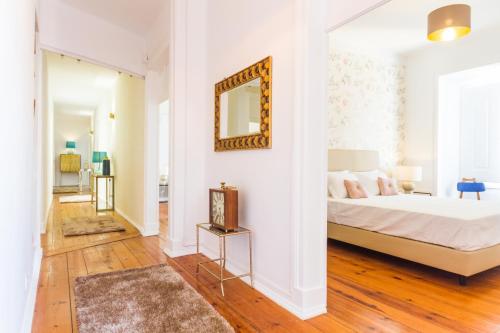
For cheap private accommodation, there are some lovely guesthouses like City Lofts Lisbon .
If you’re interested in something with a bit more style, I would recommend the Lx Boutique Hotel .

And for some real luxury, have a look at the incredible Memmo Príncipe Real .
More stories about Lisbon
- Is the Lisboa Card worth it?
- How to avoid the queue for Tram 28
- The best things to do in Belém
- Why Belém Tower is so important
- How to do a perfect Sintra day trip
- Ways to see the best of Lisbon's tiles
- Exploring the local Graça neighbourhood
- Discover the art gallery through the metro
- The cool Park of Nations architecture
8 thoughts on “Damn, that tram is crammed!”
You’ve convinced me this would be so delightful. I`ve never thought that Lisbon could be a reat place for the holidays, but it is.
Anyone who waits 2 hours to get on that tram is a moron. People get on, sit, and when there are no seats left, people just keep waiting for the next one to get a seat. Just skip the people who are waiting and get on the tram. You don’t get a seat immediately, but you might at the next stop.
And it is possible to go inside the parliament building, I don’t remember exactly but I believe it’s once a month on the weekend. I’ve been inside twice.
Otherwise, nice recap of the tram sequence.
For info, the Sta Catarina belvedere is closed.
Take any of the trams (25) or buses (701, 709, 774) that go to Prazeres, and board the 28 there. The only other people waiting in line at Prazeres will be the people who just came off the 28, so the wait will be much much shorter, and you have a better chance of getting a seat instead of standing.
(You can catch the 25 or 774 at Praca da Figueira or Praca do Comercio, and the 709 at Restauradores.)
Ridiculous!
I LIKE YOUR SUGGESTIONS, HOWEVER WALKING THE TRAM 28 IS EXHAUSTING BECAUSE OF THE HILLS. HOW ABOUT THE E15 OR THE E28 TRAM?
For those who don’t want to walk: board the tram at Campo Ourique! I was in Lisbon end of December 2019 and it was super busy with tourists. We only had to wait for about 10 minutes and we got a seat on the tram. Very comfortable and with the windows open great views alon the route. Crazy long queues at Martim Moniz and impossible to board the tram in the city centre!
This guide for the Tram 28 in Lisbon was awesome. i truly enjoyed reading and inspire me. Excellent work!!!
Leave a comment Cancel reply
In portugal, i recommend:.
🏨 Hotels: Booking.com 👩🏫 Tours: GetYourGuide 🚗 Car hire: Discover Cars 🚌 Bus & train: Omio
Find me on the socials:
Subscribe for news and deals:.
Melbourne to Sydney drive itinerary
With stunning coastlines, epic national parks, and charming heritage towns, these are the best stops on a Melbourne to Sydney road trip.
Written by Michael Turtle
Michael Turtle is the founder of Travel Australia Today. He has been a journalist for more than 20 years and loves exploring different parts of Australia.
Michael Turtle is the founder of Travel Australia Today and has been a journalist for 20 years.
Last updated: November 22, 2023
Each day of the Melbourne to Sydney road trip
Jump down to a particular day - or keep reading for my complete Melbourne to Sydney itinerary.
• Day 1: Melbourne to Walhalla • Option: Melbourne to Wilsons Promontory • Day 2: Walhalla to Metung • Day 3: Metung to Mallacoota • Day 4: Mallacoota to Narooma • Day 5: Narooma to Jervis Bay • Day 6: Jervis Bay to Sydney
One of the best road trips you can do in Australia has to be the Melbourne to Sydney drive, tracing the coastline past stunning beaches and through epic national parks.
There is the practical benefit – that you get between the country’s two largest cities without having to worry about the logistics of a flight. But I also think it’s got a fantastic amount of diversity – big cities and small towns, the beach and the bush, relaxation and adventure, nature and culture.
Imagine sailing on a lake one day, hanging out with kangaroos the next. Going deep inside an old gold mine one afternoon and then hiking along the coast by morning.
There are a few different routes you could take to get between Melbourne and Sydney.
The most direct way is to go straight along the Hume Highway, the main road that connects the two. That takes about ten hours of driving but it’s not particularly scenic. There aren’t too many places worth stopping that are close to the highway.
If you discount the Hume Highway, that leaves you with two main options – go along the coast or go inland. Both have their advantages and, if you have time (or are driving between Melbourne and Sydney in both directions) then you can try both routes.
In this road trip itinerary, I’ll be taking you along the Melbourne to Sydney coastal drive .
In total, this coastal route between Melbourne and Sydney is 1200 kilometres long and will take a total of about 15 hours driving . (So, it’s about 300 kilometres longer and six hours more driving than going directly up the Hume Highway.)
I’ve split the road trip into six days of driving but you can tailor it to your own needs. If you need to go faster, any of the stops could be skipped and that day’s drive would still be manageable. If you have some extra time, I would highly recommend choosing a couple of the spots for an extra day to hang out and explore.
How long does it take to drive from Melbourne to Sydney?
The shortest way to drive from Melbourne to Sydney is up the Hume Highway through Albury and Goulburn. This is about 900 kilometres long and will take just over nine hours of driving (without stops).
In this road trip itinerary, the drive goes along the coast. This route is about 1200 kilometres long and takes about 15 hours of driving.
Another popular drive goes inland between the coast and the Hume Highway, through the Snowy Mountains. This route is about 1100 kilometres and takes about 14 hours of driving.
There’s also another interesting road trip route that goes even further inland, through cities like Shepparton, Junee and Bathurst. It’s about 1000 kilometres long and takes about 13 hours of driving.
Where should I stop between Melbourne and Sydney?
Depending on which route you are driving between Melbourne and Sydney, there are lots of options for places to stop and quite often there a few interesting towns in close proximity that you can choose from.
In this coastal route from Melbourne to Sydney, I am suggesting stops at Walhalla, Metung, Gipsy Point, Narooma, and Jervis Bay. I think this itinerary offers a lovely mix of bush and beach, with national parks, wildlife experiences, and some heritage.
For the drive directly from Melbourne to Sydney on the Hume Highway, Albury or Gundagai are good places to stop overnight or just for a bit of a rest.
Is it worth driving from Melbourne to Sydney?
If you want to see the best of Queensland, then it’s definitely worth driving from Brisbane to Cairns. It’s along this stretch of coast that you’ll find most of Queensland’s natural wonders, plus the scenery between them is beautiful.
There’s also plenty of heritage and cultural attractions on the drive from Brisbane to Cairns, and you’re going to miss most of them if you just fly between the two cities, or don’t take the time to stop regularly along the way.
Is it cheaper to fly or drive from Melbourne to Sydney?
If all you want to do is get between Melbourne and Sydney, then flying is both a cheaper and a faster option. The flight will take only an hour and, even with transport to and from the airport, it’s probably only about a two hour trip, compared to nine hours of driving.
The cost of a flight between Melbourne and Sydney varies a lot throughout the year, but you can get a one way ticket for as low as $60 on a budget airline. If you were to drive, the cost of petrol would be at least double that. There are also costs like tolls, and potentially accommodation if you don’t go the whole way in one day.
However, flights can get more expensive in peak time and at the last minute. if the cheapest flight available is more than $150, then it might start to be cheaper to drive in one day.
Is there a train from Melbourne to Sydney?
Yes, there is a train from Melbourne to Sydney that connects the capital cities through stops including Wangaratta, Wagga Wagga, and Goulburn. It takes about 11 hours and the cheapest adult tickets start at $78.
The train goes twice a day in each direction. One of the trips is during the day, and the other is overnight. The train is relatively basic, though, and certainly not the standard you find with high-speed trains in Europe or Japan. (Although new trains are coming in 2023, which look much better!)
Although there are lots of places to stop along the Melbourne to Sydney drive, I’ve chosen the ones in this itinerary because they offer some of the most interesting activities, with significant national parks or iconic experiences. There’s also some diversity in these stops, rather than just going to a nice beach each day.
The drive time each day is also quite short in this itinerary, and that’s intentional. I’m assuming that you’re doing the coastal route between Melbourne and Sydney because you want to see the sights along the way, rather than just get between the two cities. But feel free to change things as you go – there are lots of other options, particularly along the NSW South Coast .
As you can see on the map above, there’s lots of ground to cover. So, with all of that introduction out of the way, let’s get into the details of this Melbourne to Sydney drive itinerary!
Melbourne – Walhalla
2h 30m of driving (180 km)
The first part of today’s drive will just be getting out of Melbourne, through the city’s southeastern suburbs. You may hit a little bit of traffic if you leave during peak hour, but the roads are quite good.
As the countryside opens up, you’ll be driving through the relatively flat agricultural lands of West Gippsland, known primarily for dairy farming but also for a burgeoning gourmet food scene.
The highway goes through some of the region’s towns and bypasses some of them, but there are plenty of quaint places to stop for a coffee along the way, including Warragul, Yarragon, and Moe.
On today’s drive…
Today’s drive is just long enough that you’ll probably want to stop somewhere to break up the journey and have a rest. The biggest town you’ll pass through is Warragul, which is full of 19th century heritage and also has an impressive collection of art galleries. The Bean Scene has great coffee, or you can pick up some supplies at Stella’s Pantry .
Although it’s quite small, another option for a break is Yarragon. I would recommend a coffee or lunch at the Fozigobble Cafe , which has organic food and a lovely garden at the front.
Or the last option before you start climbing up the hill is the historic town of Moe, where there are some leisurely bushwalks to stretch your legs. The main attraction here is Old Gippstown , a recreation of Gippsland in the 1850s.
Today’s destination is Walhalla, an old gold mining town that was one of the richest places in Australia in the late 1880s. Thousands of people lived and worked here during the boom. Now, though, there are less than 20 permanent residents.
Walhalla is a peaceful place and it’s easy to relax – but the town has also retained the charm of its golden era and there’s plenty to see.
I would recommend a tour into Long Gully Extended Gold Mine, to get a sense of what it would have been like for the workers. It’s incredible to think that most of the passages here were painstakingly cut away by hand.
It’s also worth taking a ride on the Walhalla Goldfields Railway, a charming heritage train that crosses a series of bridges before reaching its destination 20 minutes later, before heading back. The scenery along the way is beautiful!
And you’ll also be able to spend a couple of hours wandering the streets, exploring the bushland around town, and hanging at some of the local businesses. I’ve got more tips here on things to do in Walhalla .
THE BEST ACCOMMODATION IN WALHALLA
Although it’s a small town, there are quite a few places to stay in Walhalla – and they all come with a little bit of history.
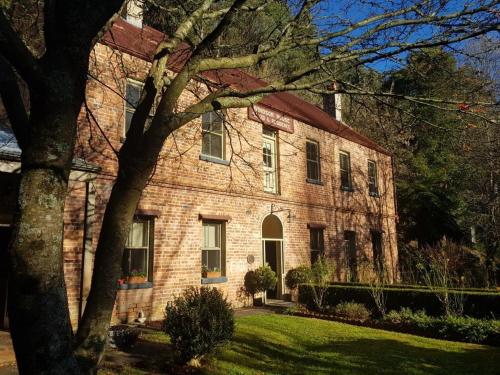
Built in 1890, Windsor House is one of the last original properties in Walhalla and offers five rooms for B&B accommodation.
SELF-CONTAINED
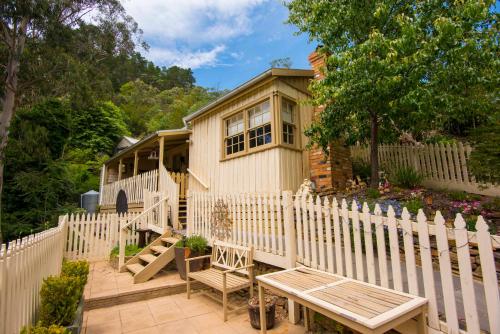
Although it’s been renovated, the 1896 cottage known as Walhalla Mill House is a self-contained property and can sleep up to 4 people.

On the outskirts of town, Stringer’s Cottage is a compact self-contained property that’s full of charm and authentic heritage.

The most popular option in town, Walhalla’s Star Hotel has an original facade but has been rebuilt with boutique suites and an excellent restaurant.
Melbourne – Wilsons Promontory
3 h 10m of driving (220 km)
Now, before we go on to day 2 of the itinerary, I want to give you an option for a different way to start this drive from Melbourne to Sydney.
I know I promised a coastal drive, but you may have noticed the first day’s destination was Walhalla, which is very much inland. I did it this way because there are going to be plenty of beaches and water from now on, and a little bit of Gold Rush heritage is important when you’re visiting Victoria.
But, if you do want to stick to the coast, then the alternative option for day 1 is to drive down to Wilsons Promontory instead. It is one of Australia’s best national parks and a very popular destination for people from Melbourne – particularly during school holidays.
A good place to stop on the drive from Melbourne to Wilsons Promontory is Meeniyan. If you need a meal or a coffee, make sure you check out Moo’s at Meeniyan , which does some of the best food in town.
You may also need to pick up some supplies here in Meeniyan for your overnight stay in the national park because Wilsons Promontory has a shop that’s open during the day where you can get food, but there’s nothing available in the evening. There’s a supermarket in Meeniyan or you could ask Marty at Moo’s to fix you up a dinner pack to cook on the barbeque (that’s what I did).
Make sure you also get petrol here or at nearby Fish Creek because there are no petrol stations at Wilsons Promontory.
Wilsons Promontory is the southernmost point of mainland Australia and it has an amazing collection of natural offerings. There are huge granite mountains, forest, beaches, and rocky outcrops. You can relax on the sand or go hiking for hours (or even days).
The main area in Wilsons Promontory is Tidal River, where you’ll find a shop and many of the camping sites (and a few other accommodation options). From here, you can explore the parts of the park that are easy to access.
If you’re only planning to stay one night, you won’t be able to access the areas that need long hikes in. I would recommend you walk to Squeaky Beach, which got its name because of the sound the sand makes when you walk on it. And catch the sunset at Whisky Bay, which is only a ten minute drive from Tidal River and really worth the effort.
You could also hike up to the top of Mount Oberon. It’s relatively steep but manageable for most people and only takes about an hour from the closest car park. The view from the top is spectacular and you can look out over most of The Prom.
For more information, I’ve got a story about things to do at Wilsons Prom .

THE BEST ACCOMMODATION AROUND WILSONS PROM
You’ll usually need to book in advance to stay at Tidal River in the national park, but you can check availability here . Otherwise, there are these options near the park’s entrance.
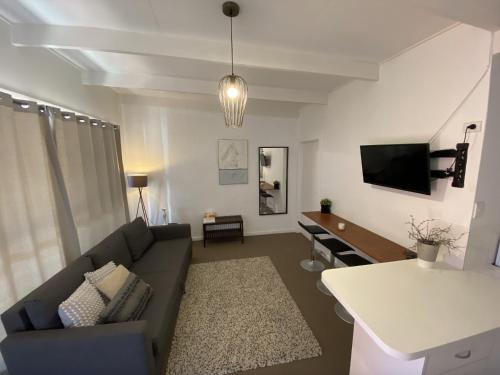
The cosy rooms at Prom Coast Apartments come with a full kitchenette – and are only a few minutes from the beach.

You get wonderful views down the hill to the coast at the large and modern Black Cockatoo Cottages .

There are a few different sized houses at the charming Driftwood Villas , with the largest able to sleep 12 people!
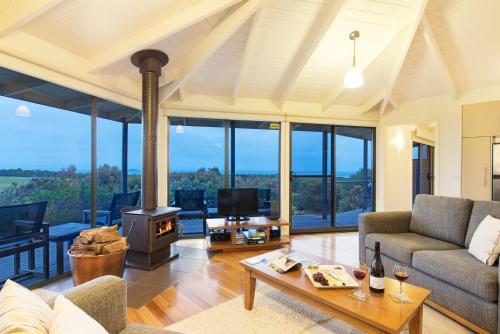
The views are incredible from Limosa Rise , plus this self-contained accommodation has a great design that makes you feel immediately at home.
Walhalla – Metung
2h 30m of driving (190 km)
Heading down from the mountains towards the coast, most of today’s drive will be through agricultural land, with the silhouettes of the hills to your left, and the ocean out of sight to the right.
The destination for today is the Gippsland Lakes, the largest navigable inland water system in Australia. It’s a perfect place for a holiday because the lakes offer plenty of opportunity for water sport, while the beach is just metres away.
If you’re looking for somewhere to stop along the way, there are two good options. The first is Sale, a former port that has an affluent heritage to it. There are a few things to see in town, and the Redd Catt restaurant is nice for a meal or a coffee.
Closer to Metung, another good rest spot is Bairnsdale, which quite a few people actually use as a base when they visit the Gippsland Lakes (so there are lots of shops here, if you need to stock up on anything). Pop into the East Gippsland Art Gallery for a bit of culture and don’t miss the striking murals in St Mary’s church.
Although Lakes Entrance is the main tourist centre of this part of Gippsland Lakes, I recommend you stay instead at Metung, which offers a more charming village atmosphere. You can potter around for a quiet afternoon, or do what most people come here for – and hit the water!
Fishing and boating are some of the most popular activities and a local company in Metung called Riviera Nautic offers a couple of options, including a leisurely cruise around the lakes.
You can also hire a little motorboat from them and drive yourself around, pulling into the small bays, powering across the lakes, and stopping at the beach. Or tkae it more slowly in a kayak or on a stand up paddle board. You’ll be amazed at how many water birds you’ll be able to get close to.
For food in Metung, I would definitely suggest eating at the Metung Hotel for dinner and Bancroft Bites for breakfast.
THE BEST ACCOMMODATION IN METUNG
Most of the accommodation in Metung is aimed a long stays, with lots of self-contained multi-room options. But you can definitely just stay a night or two – and you may appreciate the facilities on a long road trip.
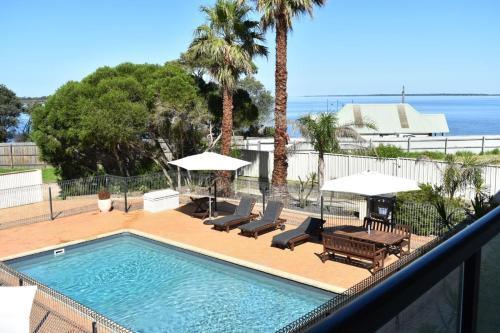
With views of the lake from most of the rooms, the Metung Waters Motel is great value for clean and comfortable rooms.
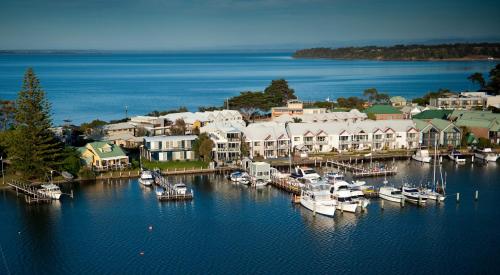
As well as the spacious apartments of different sizes, the Moorings at Metung also offer swimming pools, a tennis court, and private marina.

Just a few minutes from town, Edgewater Terraces have a serious of large waterfront properties that are perfect for families or groups.
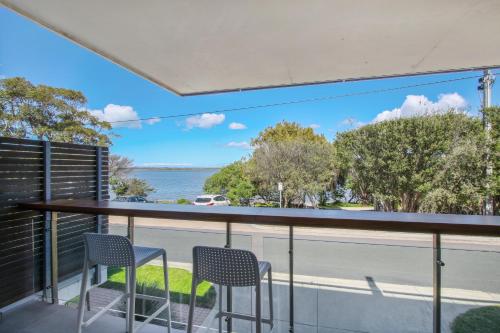
The modern apartments at 5 Knots Metung are self-contained but feel more boutique than some of the town’s other options.
Metung – Mallacoota
2h 30m of driving (210 km)
Today’s drive is one of the prettiest of the whole trip, with lush Australian bush along both sides of the road for most of the way, as you cut through national parks and state forests.
The road is easy to drive but it has enough dips and turns to keep it interesting, and as the sun shines through the treetops, the various lighting effects create some glorious landscapes.
There aren’t many stops along the way but you’ll probably want to get to today’s destination of Croajingalong National Park early anyway, so you can make the most of your time.
As I mentioned, there aren’t many obvious places to stop along the way because this stretch of the road is the least populated of the road trip.
To break up the journey today, I suggest a stop at Cann River, which you’ll reach after about two hours. Although there isn’t much here, the Pelican Point Coffee Lounge is good for a coffee or a meal.
Welcome to the enormous Croajingalong National Park, which stretches for more than 100 kilometres along the coast. UNESCO has declared the park a World Biosphere Reserve because of the natural diversity it has within it. It’s one of the most interesting natural locations in Australia but, for some reason, gets a limited number of tourists.
Getting around Croajingalong is not easy and you won’t be able to see a lot of it in one afternoon. Unless you plan to stay longer (which would be great), I suggest you spend your time seeing a few different aspects of Croajingalong National Park. The coastline is quite spectacular and you can access its beaches from quite a few places off Betka Road, just south of Mallacoota.
Hiking up to the top of Genoa Peak gives you fantastic views and is relatively easy, taking about 30 minutes from the carpark. Many of the bushwalks inland from the coast will get you up close with some Australian wildlife (I saw some koalas on the track I took).
You should also try to get out on the water and explore the isolated beaches and bays that can’t be reached by car. I’ve got more information about all of this in my story about things to do in Croajingalong National Park .
The main town in Croajingalong National Park is Mallacoota, and you’ll find accommodation and restaurants there. Although I think the quieter community of Gipsy Point is actually a nicer place to stay, if you’re looking for something less busy.
THE BEST ACCOMMODATION IN CROAJINGALONG
There are two options for places to stay. Most of the accommodation is in Mallacoota, but you’ll find a much quieter community nearby at Gipsy Point.
HOLIDAY PARK

Set amongst bushland but with easy access to the beach, the Shady Gully Caravan Park has cabins that can sleep up to six.
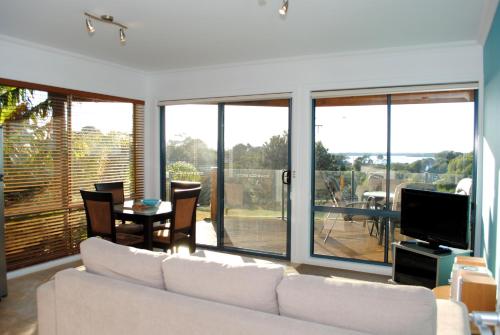
Although the Wave Oasis B&B is set up like a guesthouse, each small apartment is self-contained and feels quiet and private.
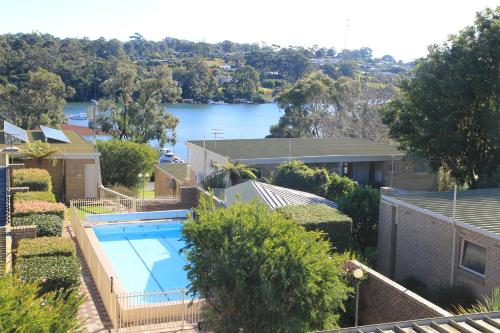
With apartments of different sizes, Gowings of Mallacoota is great for families or longer-stay visitors who’ll appreciate the amenities.

Away from the main town, the luxurious villas of Gipsy Point Lakeside offer views across the water and kangaroos grazing on the grass in front.
Mallacoota – Narooma
2h 20m of driving (200 km)
Crossing the border today, you’ll now be in New South Wales for the second half of this Melbourne to Sydney drive.
After passing along the edge of the (soon to be renamed) Ben Boyd National Park, you’ll hit the first of the coastal towns, Eden. From here, the scenic drive oscillates between the coast and the bush, giving you great views of the landscapes. There’s an inland highway that is a bit faster, or take the coastal road to see the townships along the way.
The NSW Far South Coast is a popular holiday region (although, because it’s a long drive from Sydney or Melbourne, tends to attract longer stays, rather than weekend visits). But this means there are lots of places to stop, things to do, and towns where you can stay overnight.
I’ve chosen Narooma as today’s destination, but any of the other nearby towns (such as Moruya or even Batemans Bay) are also great options.
If you’re looking for more than just a rest stop on this stretch of the drive, I would recommend heading to Pambula in time for one of Captain Sponge’s Magical Oyster Tours .
The region is famous for its oyster industry and your guide will take you around Pambula Lake to show you the oyster farms and explain the whole process. You’ll even be able to taste a few of the local fresh oysters in a beautiful natural surrounding. You can read my story about the Pambula oyster tour .
Nearby Merimbula also makes for a lovely rest. And, just before you get to Narooma, hop out at Tilba Tilba to explore this gorgeous heritage town.
Narooma is a wonderful coastal town and you’ll immediately see why it’s such a popular holiday destination. Quiet and laidback, you can hang at the beach or go cycling along the coast track, and then refresh with excellent dining options like the Whale Inn and the Quarterdeck .
One of the best things to do in Narooma is a trip to Montague Island, which is home to hundreds of friendly seals. You can head out to the island on a boat and watch them safely from deck – or you can even jump in and swim with them, like I did.
The seals are really playful and this is a wonderful experience. You can read my story about swimming with the seals at Montague Island or you can check the availability of the tours.
THE BEST ACCOMMODATION IN NAROOMA
There are quite a few longer-stay holiday homes in Narooma, but if you’re looking for somewhere easier for a night or two, these are my top suggestions.

The Surf Beach Narooma Holiday Park is comfortable and basic, but it’s got an incredible location right on the beach.

With large clean rooms, the Top of the Town Motor Inn also has a fantastic location right in the heart of all the action.

Just a few minutes from the beach, Horizon Apartments has modern self-contained units of different sizes.

The charming decor of Anchors Aweigh sets the scene for this quirky guesthouse where you’ll instantly feel right at home.
Narooma – Jervis Bay
Continuing up the New South Wales South Coast, you’ll start to go through some slightly larger towns with even more developed tourism infrastructure. But it’s all still beautifully laidback and, with the beaches and cafes, the whole region feels like a constant summer holiday.
I would suggest taking this stretch of the drive slowly and don’t be afraid to stop a few times along the way for a quick swim, a coffee, or even just a wander around town. There’s lots to see and do on the NSW South Coast .
Just after Moruya, you’ll reach Mogo Wildlife Park , which is famous for its work in breeding endangered animals. It may seem like an odd place for a zoo, but there’s an impressive collection of species here – including lions, giraffes, tamarins, gibbons, gorillas, and snow leopards.
The biggest town you’ll pass through today is Batemans Bay, which is certainly a good place to stop, with a large range of cafes and restaurants for lunch. If you’ve got a bit of time, you could do for a bushwalk in the Clyde River National Park, or rent a kayak for a paddle up the Clyde River.
Ulladulla also has good food options but if you’re looking for somewhere to eat around there, I would actually suggest continuing on to Milk Haus near Milton, where you’ll find a converted farmhouse with excellent coffee and meals.
My recommendation for tonight’s stop is Jervis Bay, another very popular tourist destination with lots to offer. Within Jervis Bay, there are several towns where you can base yourself – Huskisson is the main centre, Vincentia has lots of accommodation, and Hyams Beach is small but famous for its white sand.
In fact, the white sand at many of the beaches is one of the main attractions and it’s easy to just spend your time swimming and hanging out at the coast. But other activities include bushwalking, whale watching tours, and kayaking.
A wonderful part of Jervis Bay is Booderee National Park , which is one of just a handful of national parks administered by the Federal Government (like Kakadu National Park ). It has glistening white beaches, high cliffs, and crystal clear water for swimming. It’s also home to the only Aboriginal-owned botanic gardens in the country.
I’ve got more details in my story about things to do in Jervis Bay . You’ll see why it’s such a popular destination during the school holidays.
THE BEST ACCOMMODATION IN JERVIS BAY
The Jervis Bay accommodation is quite spread out, although there’s a lot around Huskisson and Vincentia. Holiday homes are popular for long stays, but I’ll recommend some easier options here.

A large site with a pool, playground and water access, Jervis Bay Holiday Park is a perfect option for families and casual holidays.
Right in the centre of Huskisson, the Jervis Bay Motel has modern comfortable rooms with easy access to restaurants.
BUSH COTTAGES
In a relaxing site amongst the gum trees, Bay and Bush Cottages has a series of cool unique accommodation options.
BEACH COTTAGES
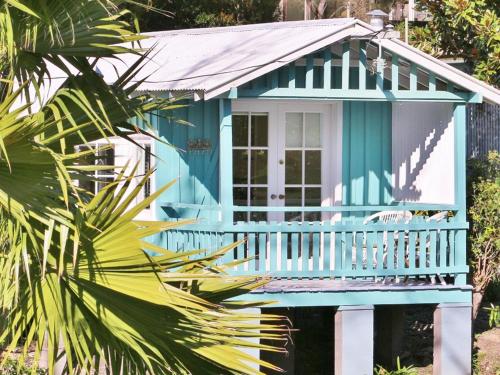
The series of seven cute cottages at Hyams Beach Seaside Cottages are well-equipped and right on the coast for a wonderful boutique experience.
Jervis Bay – Sydney
3 hours of driving (200 km)
The final day of driving will take you anywhere from 2.5 hours to 3.5 hours, depending on the day and the time of the day. With that in mind, it’s worth trying to avoid arriving in Sydney during peak hour because the last stretch can get very slow with traffic.
You could just power through until the end, but there are still some wonderful things to see along this stretch. For the first part of the drive, you’ll continue through charming South Coast towns and there are a few that I would recommend for rest stops (and a little exploration).
The first option is Berry, an inland town full of heritage buildings and quaint stores and cafes. The main street is lined with gorgeous buildings and there are plenty of boutique shops with local produce or collections of homewares. Down the side streets, the chocolate shop and the tea shop are both very popular.
Further up the coast, Kiama is one of the most beautiful towns in the region, with great swimming beaches, calm azure rock pools, and large grassy slopes for picnics. There’s also the famous blowhole, where waves crash through and spray up into the air. There are lots of places to eat in the main part of town or near the big rock pool.
Or, if you want to get a bit more driving in before you stop, then Thirroul is a excellent option for a stop. It’s off the main highway so doesn’t get as much traffic as some other towns – although it’s become popular in recent years.
The beaches and pools are fantastic for a swim, there are more than a dozen options for good coffee, and you can even do a bit of a hike up the Illawarra Escarpment if you feel like getting sweaty! I’ve got more details here about things to do in Thirroul .
The final stretch of highway, past the Royal National Park, will be quite fast and there are no convenient places to stop, without doing a detour. But soon you’ll reach the southern edge of Sydney and begin to make your way through the suburbs.
THE BEST ACCOMMODATION IN SYDNEY
You may find the city centre the most convenient location, but the neighbourhoods have a bit more character. For more details, see my story about where to stay in Sydney .
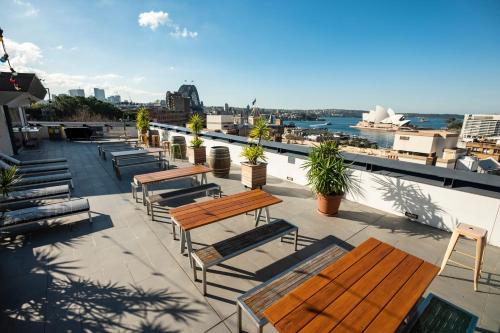
With views that you won’t believe belong to a hostel, the Sydney Harbour YHA in The Rocks is a pretty special hostel.
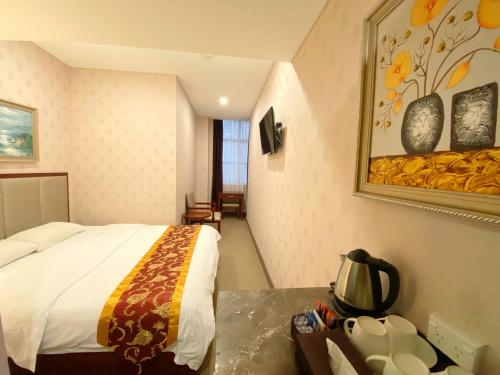
It’s quite a rare find in Sydney, but Megaboom City Hotel has great value rooms in the centre of the city – just don’t expect a large or modern space.
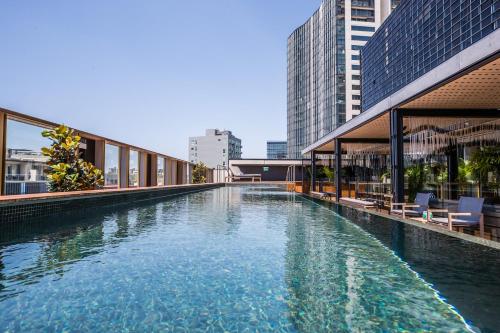
The incredible renovation of this pub has turned The Old Clare into one of Sydney’s coolest hotels, complete with a rooftop pool.

I think the Pullman Quay Grand is the best luxury hotel because of its harbourside location and beautiful apartments.
And that brings us to the end of the itinerary for this Melbourne to Sydney drive along the coast. I hope you can see why these are my suggested stops between Melbourne and Sydney, because I think each has its own special reasons to visit.
If you stay in each location for just the night, it’ll be a six-day road trip from Melbourne to Sydney. I would suggest trying to extend for a night or two, though, and spend a whole day in at least one of the stops – perhaps Metung, Mallacoota, or Jervis Bay.
Regardless, this is a wonderful way to see this part of Australia and the beautiful southeastern coast. Enjoy!
More Victoria stories
- The best places to visit in Victoria
- The top things to do in Melbourne
- The best museums in Melbourne
- Coastal itinerary for a Melbourne to Sydney drive
- The best things to do in Ballarat
Follow on facebook:
Subscribe for news and deals:.
top stories:

- Fshoq! Blog
- » List of travel websites and blogs
- » Time Travel Turtle
- Time Travel Turtle
The page Time Travel Turtle belongs to my big list of websites and travel blogs. For a full list, visit the largest list of travel and travel blogs .
Basic information about the travel page
Here you will find basic information about this site, such as its title, description or website address. This page has been added to 22th September 2017, 16:46.
All titles of this site.
- A travel blog taking you 'beyond the brochure' since 2011
Page address
Url address of this page is https://www.timetravelturtle.com/ . Link will open in the new tab.
Site descriptions for travelers
All descriptions of the page.
Time Travel Turtle is a travel blog by journalist Michael Turtle that explores the culture, history and people of the world.
The names of the people who run the site
If you would like to know who is behind the travel page, the names of people can be found below:
SEO (positioning) information about the site
The following table provides information on the strength of the page, including the number of links leading to the page, the Google PageSpeed ranking, and the Alexa and Moz rankings.
Popular entries
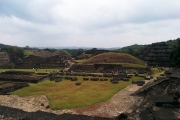
El Tajin - Ancient City of the Totonac Indians

Canada Road Trip #4: Banff National Park

Lightroom tutorial #1: Basics
The Last Samurai of Aizuwakamatsu
www.timetravelturtle.com
As fire raged in the city below them, the small group of teenage warriors watched on in horror. The year was 1868 and the Boshin War – also known as the Japanese Revolution – had made its way north to the the city of Aizu.
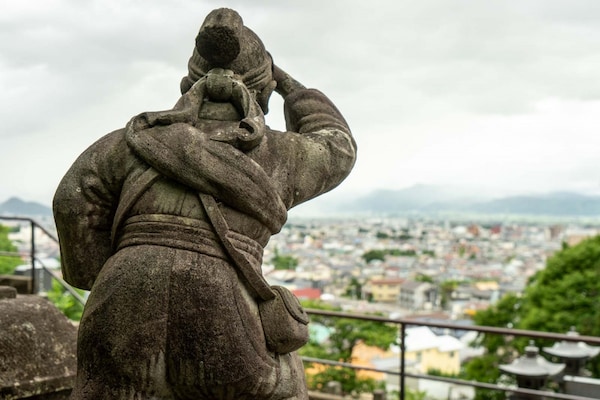
https://www.timetravelturtle.com/samurai-history-aizu-japan/
This group of about 20 teenagers had been in the thick of it, fighting for their home and their honour, but had retreated to a viewpoint on a hill to assess the situation. When they saw the fire, they thought their castle – the last stronghold – had fallen. The enemy may have taken their home, they thought, but it could never take their honour. The youngsters took out their swords and their knives… and killed themselves in a ritual suicide. This military unit of 16 and 17-year-olds was called the ‘Byakkotai’ and their mass suicide has become the most famous story of the Battle of Aizu. It’s made even more tragic because they were actually wrong – the castle had not fallen. Some of the city was on fire and that made it look like the stronghold was also alight. Their honourable deaths were unnecessary.
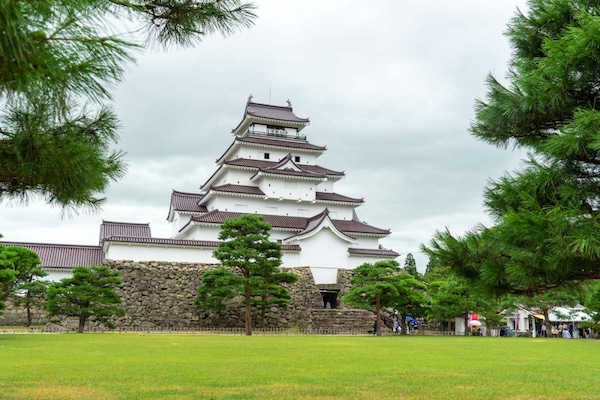
But, although this story may be the most memorable, it’s what the Battle of Aizu represented that is the most important. The Aizu Clan was locked in battle with the Imperial Army, who were trying to restore the power of the Japanese Emperor to rule the country. Aizu was on the side of those who wanted to keep the shogunate system, where power lay in the hands of feudal lords.

This battle here would be one of the last. The castle at Aizu was besieged and, after a month, the rulers surrendered. It was the beginning of the end and it wouldn’t be long until the Emperor Meiji was able to take control of all of Japan. Meanwhile, the armies of Aizu and its allies were banished, stripped of all status. These warriors had been a critical part of Japanese society for centuries but those here in Aizu were the last.

Who were they? Well, of course, I’m talking about the samurai. The legendary Japanese warriors who were so intertwined with the story of this country would finally come to an end here. Aizu is the story of the last samurai.
The Samurai History in Aizu
The city of Aizu, which is now called Aizuwakamatsu, has long ago thrown off the shame of being on the losing side of the Japanese Revolution. Now the city celebrates its samurai heritage. And, if you’re interested in learning more about the samurai, it is a perfect place to do that. There are lots of very well-restored historical sites, mixed with fun experiences, and authentic culture.
Tsuruga Castle

The most prominent site in Aizuwakamatsu is Tsuruga Castle (the one the Byakkotai thought had burned down). The first castle on the site had been built in 1384 and there had been several versions of it by the time of the Battle of Aizu, in which it was badly damaged. After the war, the new government demolished what was remained and it was left in ruins for almost a century. What you see today is a reconstruction of how Tsuruga Castle looked from 1639 until it was destroyed. It’s five storeys high and you can go inside and climb to the top.
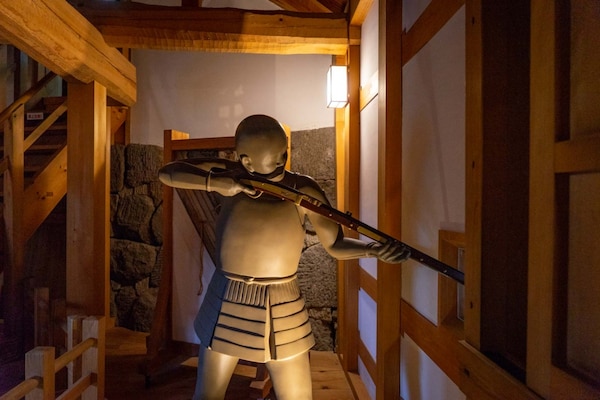
There’s a museum inside with an exhibition telling the history of the site and, at the top, you get excellent panoramic views across the city. These days, you’ll also find a nice tea room in the castle complex, which is a tribute to one of the 16th century rulers who was a famous tea master.
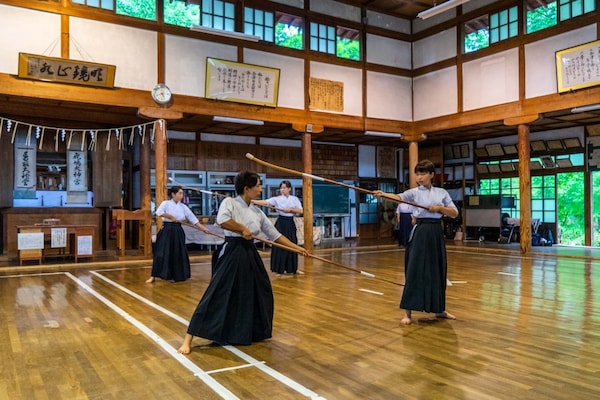
Just outside the walls to the castle, on the city side of the moat, is the Butokuden. It’s a martial arts dojo that was built here in 1934. Make sure you have a look as you go past to see if there’s anything happening inside. With any luck, you’ll see some youngsters practising kendo, the Japanese martial art with a wooden sword, or with a naginata , a spear-like weapon that was favored by female warriors. The samurai may have gone but their spirit lives on.
Nisshinkan Samurai School

The samurai in Aizu had a strong tradition of encouraging youngsters. In 1803, the feudal lord here established a special school for the children of the samurai where they would do their normal lessons – and learn how to fight! The school was called the Nisshinkan and it was built right next to Tsuruga Castle. During the Boshin War, it was burned down, but an exact replica has now been rebuilt in another part of the city so you can visit.

This is the school where the Byakkotai teenagers would have trained. There’s a pool, an archery field, and a shooting range. In one of the rooms, there’s even a sign that points out that the students were taught how to kill themselves. The school complex is quite large and it’s definitely worth visiting. You can even try your hand at archery to see how good a samurai you would have been!
Aizu Bukeyashiki Samurai Residence
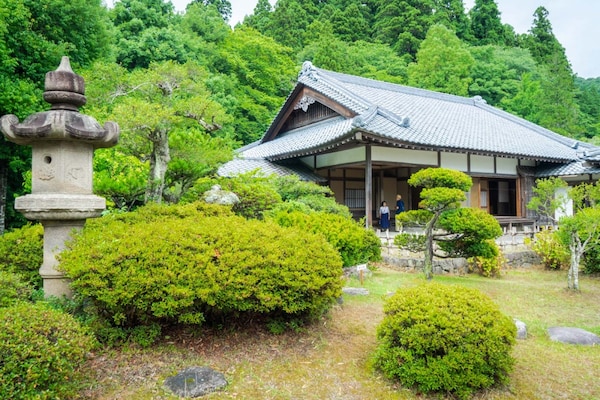
While we mostly think of the samurai as being warriors, it’s important to also understand that they were part of the elite ruling class in the Japanese shogunate. Many of these samurai were quite wealthy and they owned large estates where their extended family and staff lived. You can visit one called Aizu Bukeyashiki to get a sense of what they were like. This samurai residence is a restoration of one that burned down during the Boshin War. It has 38 rooms spread out over about three acres.
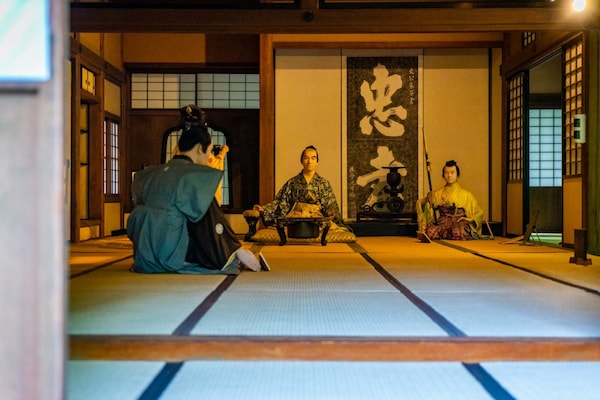
What’s interesting is to see the intersection of the public with the private. The family lived in traditional comfortable rooms in one part of the residence, while there were ornately-decorated formal entertaining rooms at the other end. I was particularly impressed with the private bathroom for the samurai that was built without rafters so that ninjas couldn’t hide there and kill anyone going to the toilet!
Mount Iimori
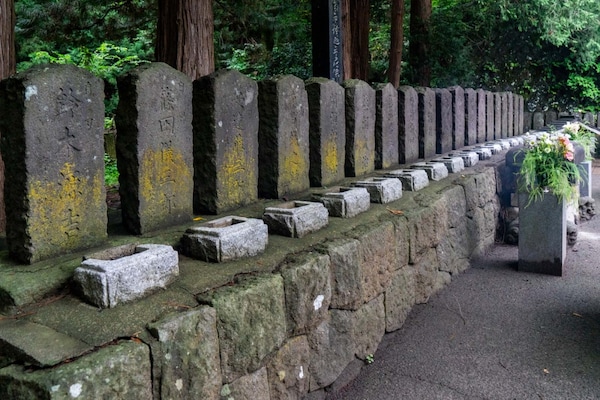
When the Byakkotai teenagers retreated up a hill to get a view of Aizu, it was Mount Iimori that they chose to climb. The mountain has become famous as the location of their ritual suicide and there’s a large memorial to the teenagers here that is worth seeing. It wasn’t always this way, though. For a while, the children were considered to be cowards by the people of Aizu. It was only after some time that the story evolved into one of honour.

One day, the Italian leader Mussolini heard about the story of the Byakkotai. He was so impressed with their devotion and ultimate sacrifice that he donated a column from the Archaeological Site of Pompeii and you can still see it standing here today. Mount Iimori has some other sights as well. As you arrive, you’ll see some beautiful shrines surrounded by trees with a stream flowing past.
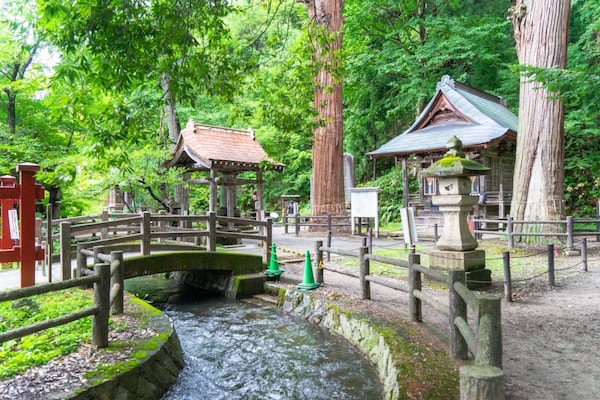
Go up the stairs and you’ll find a temple called Sazaedo. It has a special design with a double-helix staircase that means you will walk up and down without passing anybody else. It’s quite a cool experience.
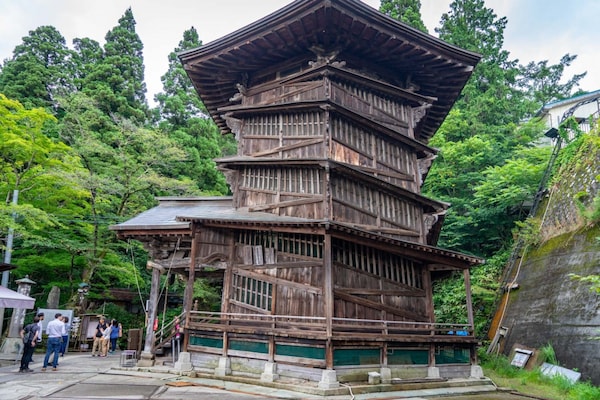
At the top, after you’ve seen the memorial, you can go down to the exact spot where the mass suicide took place. It is now an unrelated graveyard but there’s a small statue to mark the location.
Nanukamachi Street

As you explore the streets of Aizuwakamatsu – and there are a lot of interesting things to see around the city centre – make sure you take a stroll down Nanukamachi Street. It is one of the historic parts of the city and still has quite a few landmarks relating to the Boshin War. Look out for the cemetery of the Togun, the grave of Shinsengumi’s Saito Hajime, and the remnants of Shimizuya Ryokan.
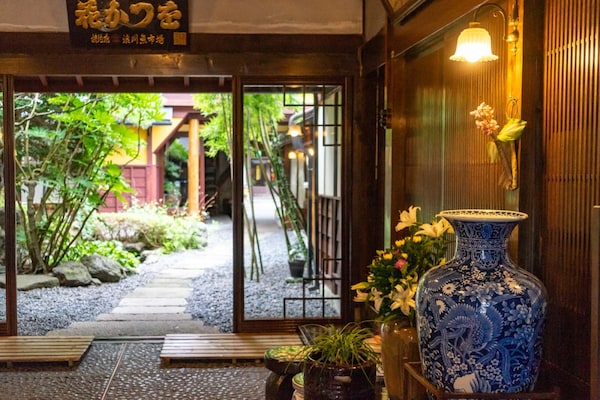
This is also one of the best parts of the city to find local handicrafts, regional food and drink, and other souvenirs. The shops along Nanukamachi Street include a confectionary, a teahouse, and a lacquerware store.
Visiting Aizuwakamatsu
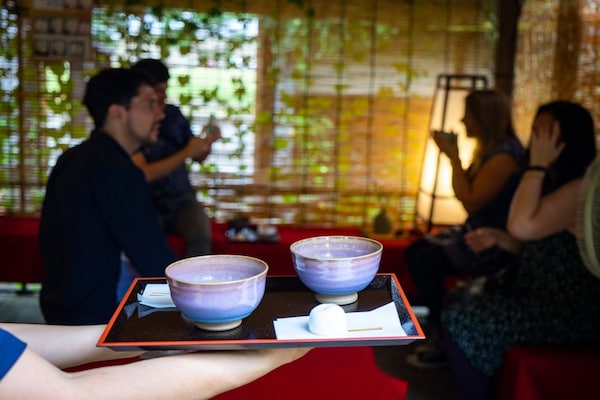
For some reason, Aizu-Wakamatsu hasn’t really been on the tourist radar until recently. Possibly that’s partly because it’s not on the Shinkansen line – but, then again, it’s still very close to Tokyo and takes less than three hours by train. Perhaps it’s also partly because it doesn’t have any of the big sights that visitors want to see on their first trip to Japan, like Kyoto or Nara. But, having now spent some time here, I think that’s where the charm lies. By not having hordes of tourists, Aizu-Wakamatsu has maintained its authenticity and small city feel. There’s a wonderful tradition of hospitality in Aizu and everyone I met was as friendly as you could hope. Yet there is still so much to see and do! In a large part, this is because of the samurai heritage, but there are plenty of other fascinating historical and cultural sites here.

Plus, there’s the food! I love Japanese food and I’ve eaten a lot of it – but I was so impressed with the local dishes and the background of the regional cuisine in Aizu. I’m going to write a whole separate story about the food soon because I’ve got so much to share! I would recommend considering a visit here for your next trip to Japan. It’s a great place if you’re looking for a part of the country with a rich heritage, delicious food, off the beaten path, but easily-accessible from Tokyo. The samurai had an expression: “Samurai die for loyalty, they don’t live with shame." When you see the city they were trying to defend, you can start to understand why they were determined to protect it. Disclaimer Time Travel Turtle was supported by All About Japan and Aizuwakamatsu , but the opinions, over-written descriptions and bad jokes are his own. Editor's Note All photos were provided by Michael Turtle. Read the original article—and join Michael as he wanders the globe in a fruitless attempt to quench his insatiable appetite for travel and adventure—at his expertly curated blog, Time Travel Turtle.
- www.timetravelturtle.com

This website uses cookies.
A Confederate statue graveyard could help bury the Old South
Doctoral Candidate in Geography, University of Tennessee
Professor of Geography, University of Tennessee
Disclosure statement
Jordan Brasher is a member of the American Association of Geographers.
Derek H. Alderman is a member of the American Association of Geographers
University of Tennessee provides funding as a member of The Conversation US.
View all partners
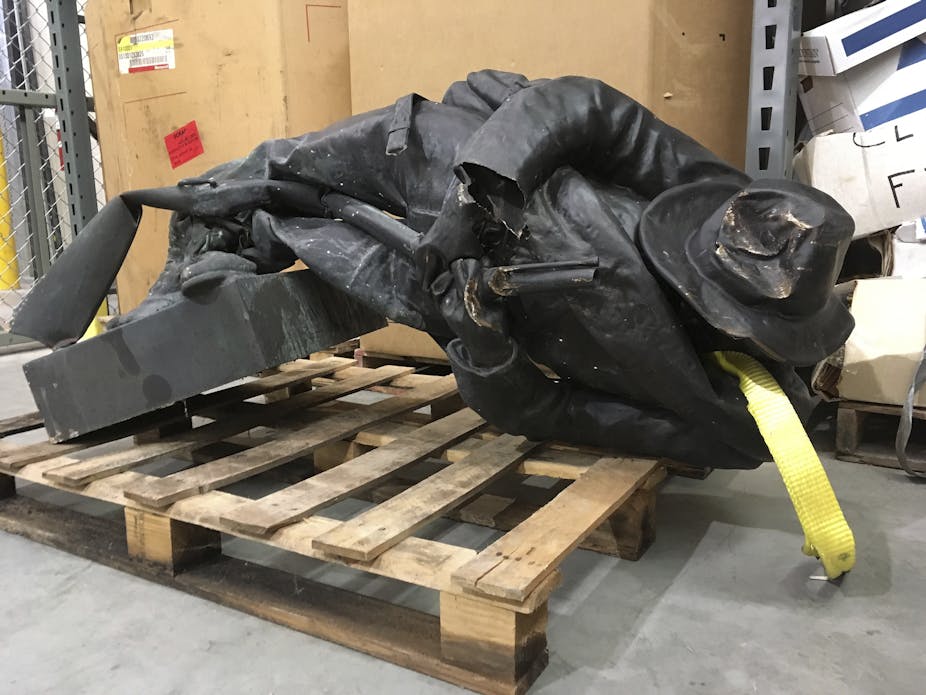
An estimated 114 Confederate symbols have been removed from public view since 2015. In many cases, these cast-iron Robert E. Lees and Jefferson Davises were sent to storage .
If the aim of statue removal is to build a more racially just South, then, as many analysts have pointed out , putting these monuments in storage is a lost opportunity. Simply unseating Confederate statues from highly visible public spaces is just the first step in a much longer process of understanding, grieving and mending the wounds of America’s violent past. Merely hiding away the monuments does not necessarily change the structural racism that birthed them .
Studies show that the environment in which statues are displayed shapes how people understand their meaning . In that sense, relocating monuments, rather than eliminating them, can help people put this painful history into context.
For example, monuments to Confederate war heroes first appeared in cemeteries immediately following the Civil War. That likely evoked in visitors a direct and private honoring and grieving for the dead.
By the early 1900s, hundreds of Confederate statues dotted courthouse lawns and town squares across the South. This prominent, centrally located setting on government property sent an intentionally different message : that local officials endorsed the prevailing white social order.
So what should we do with rejected Confederate monuments? We have a modest proposal: a Confederate statue graveyard.
Lessons from the Soviet past
Our research as cultural geographers recognizes that Confederate monument controversies – while typically considered regional or national issues – are in fact part of global struggles to recognize and heal from the wounds of racism, white supremacy and anti-democratic regimes.
The idea of a Confederate monument graveyard is modeled after ways that the former communist bloc nations of Hungary , Lithuania and Estonia have dealt with statues of Soviet heroes like Joseph Stalin and Vladimir Lenin.
Under communist Soviet rule between 1945 and 1991, Eastern European countries suffered mass starvation , land theft, military rule and rigid censorship . An estimated 15 million people in the Soviet bloc died during this totalitarian reign.
Despite these horrors, many countries have opted not to destroy or hide their Soviet-era monuments, but they haven’t left them to rule over city hall or public plazas, either.
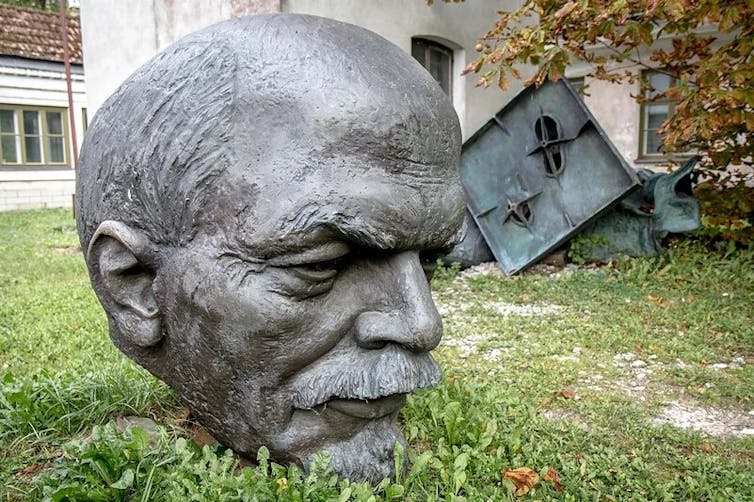
Rather, governments in Eastern Europe have altered the meaning of these politically charged Soviet statues by relocating them. Dozens of Soviet statues across Hungary, Lithuania and Estonia have been pulled from their pedestals and placed in open-air parks, where interested visitors can reflect on their new significance.
The idea behind relocating monuments is to dethrone dominant historical narratives that, in their traditional places of power, are tacitly endorsed.
A statue graveyard
The Eastern European effort to create a new memorial landscape has been met with mixed public reaction.
In Hungary, some see it as a step in the right direction . But, in Lithuania, people have expressed that re-erecting the statues of known dictators is in “ poor taste ” – an affront to those who suffered under totalitarianism.
The relocation of Soviet statues in Estonia has taken an even more interesting turn.
For the past decade, the Estonian History Museum has been collecting former Soviet monuments with the intention of making an outdoor exhibition out of them. For years it kept a decapitated Lenin and a noseless Stalin, among other degraded Soviet relics, in a field next to the museum .
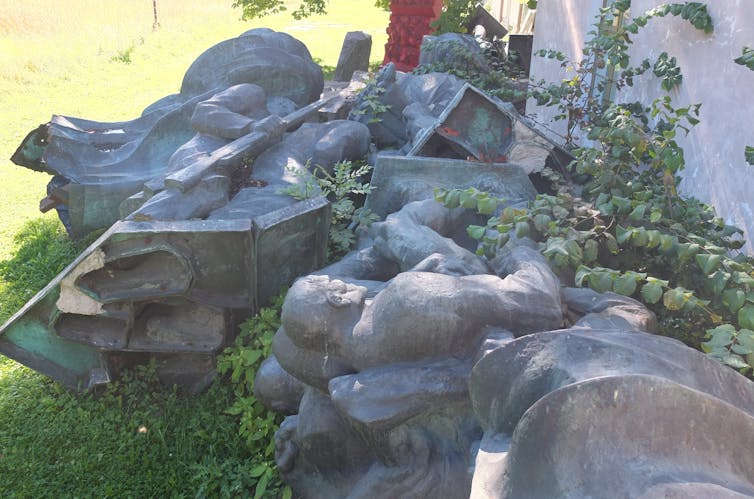
The statues weathered Eastern European winters and languished in a defunct, toppled state. Weeds grew over them. The elements took their toll.
Travel writer Michael Turtle , who visited the museum in 2015, called the field a “statue graveyard.”
“Everything here seems to fit into some kind of purgatorial limbo,” he wrote on his blog. “The statues are not respected enough to be displayed as history but are culturally significant enough to not just be destroyed.”
To this we would add that these old statues, when repurposed thoughtfully and intentionally, have the potential to mend old wounds.
Confederate monument graveyard
What if the United States created its own graveyard for the distasteful relics of its own racist past?
We envision a cemetery for the American South where removed Confederate statues would be displayed, perhaps, in a felled position – a visual condemnation of the white supremacy they fought to uphold. Already crumpled monuments, like the statue to “The Boys Who Wore Grey” that was forcefully removed from downtown Durham, North Carolina , might be placed in the Confederate statue graveyard in their defunct state .
One art critic has even suggested that old monuments be physically buried under tombstones with epitaphs written by the descendants of those they enslaved.
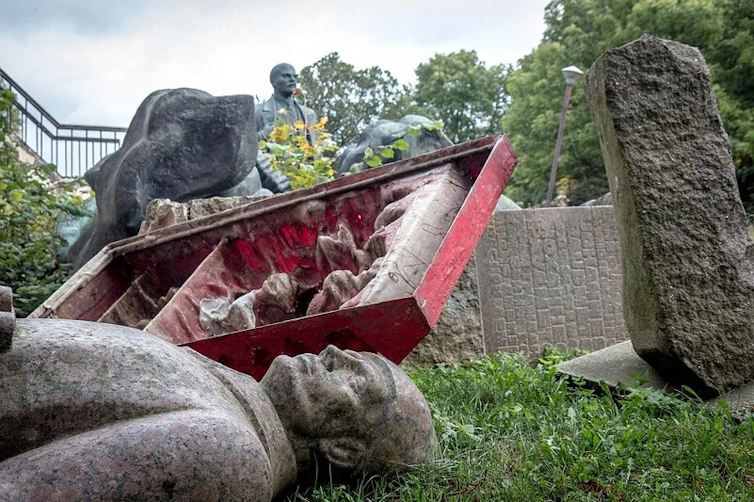
We are not the first to suggest relocating Confederate statues.
Democratic presidential candidate Elizabeth Warren , for example, has proposed that toppled Confederate statues be housed in a history museum – “where they belong.”
That has proven challenging for curators .
When The University of Texas moved a statue of the Confederate President Jefferson Davis from its pedestal on campus to a campus museum, some students criticized the ensuing exhibit’s “lack of focus on racism and slavery.” One suggested that the statue’s new setting inadvertently glorified Davis, given the inherent value conferred on objects in museums.
And since statues in museums are typically exhibited in their original, upright position, Confederate generals like Robert E. Lee still tower over visitors – maintaining an imposing sense of authority.
We believe felled and crumpled monuments, in contrast, would create a somber commemorative atmosphere that encourages visitors to grieve – without revering – their legacy. A carefully-planned and aesthetically sensitive Confederate monument graveyard could openly and purposefully undermine the power these monuments once held , acknowledging, dissecting and ultimately rejecting the Confederacy’s roots in slavery.
Planning a Confederate monument graveyard will prompt many questions. Where should it be located? Will there be one central Confederate monument graveyard or many? Who will design and plan the graveyard?
Answering these questions would not just be part of a conversation about steel and stone but about the serious pursuit of peace, justice and racial healing in the nation — and about putting the Old South to rest.

Jordan Brasher is a member of the American Association of Geographers
- Joseph Stalin
- Confederacy
- White supremacy
- North Carolina
- Vladimir Lenin
- American Association of Geographers
- Confederate Monuments
- Racial reconciliation
- Confederate memorials
- American South
- Confederate statues
- public monuments
- Racial justice
- Soviet Bloc
- Remembrance

Associate Professor, Occupational Therapy

GRAINS RESEARCH AND DEVELOPMENT CORPORATION CHAIRPERSON

Project Officer, Student Program Development

Faculty of Law - Academic Appointment Opportunities

Audience Development Coordinator (fixed-term maternity cover)

IMAGES
VIDEO
COMMENTS
get the newsletter. Time Travel Turtle is a travel blog by journalist Michael Turtle that explores the culture, history and people of the world.
It's much better to catch the train from Lisbon to Sintra. It leaves from Rossio station and costs €2.30 each way. There are a few attractions you can walk to from the train station, but some of the best are too far away. The best way to get to them is with the Bus 434, which is €7.60 for a hop-on/hop-off round trip.
Updated: December 18, 2023. Formed by glaciers, high in the mountains but close to the sea, Durmitor National Park is one of the most stunning natural reserves in Europe. The soaring peaks give you an eagle's view of the blue glacial lakes, while the canyons and forests seem to stretch out endlessly. It's a playground for the nature-lover ...
Updated: August 21, 2023. Horyuji Temple is the oldest wooden building in the world and one of the oldest temples in Japan - so it's no wonder it was Japan's first World Heritage Site! Here's what you need to know to plan a visit to Horyuji Temple near Nara. A brief history of Horyuji Temple. The best things to see at Horyuji.
Never ending footsteps//only tours and travels//Vlogs💖It's a Traveling and Vlogging channel Please subscribe 🤘
One of these, the tram 28 Lisbon line, was developed in 1914 and was designed to take residents from the central Baixa district to neighbourhoods like Graca and Estrela. Unfortunately, these trams have become effectively useless for locals in the past few years for one simple reason - tourists!
Time Travel Turtle. 15,116 likes · 1 talking about this. Time Travel Turtle is a collection of travel writing with a difference. These tales will take you be
Time Travel Turtle is a travel blog by journalist Michael Turtle that explores the culture, history and people of the world. In the Japanese city of Aizuwakamatsu, the last samurai fought to defend their way of life. On a visit to Aizu, you can experience samurai life yourself. Join travel blogger extraordinaire Michael Turtle as he does just that.
t. im. e. t. rav. e. l. Find Mementos in Internet Archive, Archive-It, British Library, archive.today, GitHub and many more! The TimeTravel service only displays links of Mementos to publicly accessible web archives.
Michael Turtle. Michael Turtle left his career in broadcast journalism in Australia to travel the world indefinitely. He continually moves from one country to the next to find the most interesting people and places on the planet. He chronicles his experiences on his award-winning travel blog, Time Travel Turtle www.timetravelturtle.com. Contact ...
There's an issue and the page could not be loaded. Reload page. 16K Followers, 1,724 Following, 2,674 Posts - See Instagram photos and videos from Time Travel Turtle (@michaelturtle)
Jump down to a particular day - or keep reading for my complete Melbourne to Sydney itinerary. • Day 1: Melbourne to Walhalla. • Option: Melbourne to Wilsons Promontory. • Day 2: Walhalla to Metung. • Day 3: Metung to Mallacoota. • Day 4: Mallacoota to Narooma. • Day 5: Narooma to Jervis Bay.
Time Travel Turtle is a travel blog by journalist Michael Turtle that explores the culture, history and people of the world.
This group of about 20 teenagers had been in the thick of it, fighting for their home and their honour, but had retreated to a viewpoint on a hill to assess the situation. When they saw the fire, they thought their castle - the last stronghold - had fallen. The enemy may have taken their home, they thought, but it could never take their honour.
A damaged Confederate statue lies on a pallet in a warehouse in Durham, N.C. on Tuesday, Aug. 15, 2017, after protesters yanked it off its pedestal in front of a government building. AP Photo ...
Aqaba - The Perfect Place For An Unforgettable Snorkeling Experience. Aqaba is a city in the south of Jordan, located on the Red Sea coast. It is the country's only port city and an important hub for tourism. The city has a population of around 140,000 people and is a popular destination for both domestic and international tourists.
Reveal both personal and business contact details, including emails and phone numbers, and close your most valuable buyers. View Time Travel Turtle (www.timetravelturtle.com) location in United States , revenue, industry and description. Find related and similar companies as well as employees by title and much more.
The first page of The Time Machine published by Heinemann. Time travel is the hypothetical activity of traveling into the past or future.Time travel is a widely recognized concept in philosophy and fiction, particularly science fiction. In fiction, time travel is typically achieved through the use of a hypothetical device known as a time machine.The idea of a time machine was popularized by H ...
Welcome to AllTurtles.com! Dedicated to providing free resources to all turtle, box turtle, terrapin, tortoise, and sea turtle enthusiasts. From free care sheets to first aid guides, and in-depth product reviews, discover everything related to the care of turtles, tortoises, and box turtles. Our Mission. We're more than just a team; we're a ...